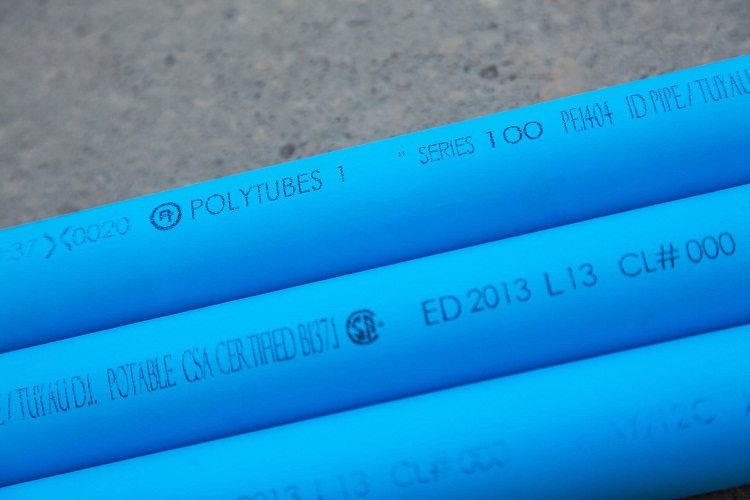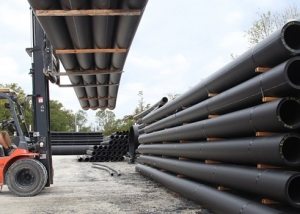Pipes made of polyethylene (PE) are widely used in the construction of water supply systems, automatic irrigation systems, in the arrangement of pools, the creation of artesian wells, etc. Their quality is regulated by the requirements of GOST 18599-2001 in force in our country. The same regulatory document contains information regarding the diameters of polyethylene pipes and describes their other characteristics.
Content
Physical properties of PE
As you know, the properties of any object are most determined by what material was used for its manufacture. Polyethylene pipes are no exception. Moreover. The physical characteristics of polyethylene brought these products into the category of one of the most popular products in the plumbing market. Let us briefly dwell on some properties of this polymer.
- polyethylene is chemically inert with respect to acids, alkalis and alcohols. However, regardless of the size of the PE pipe and wall thickness, it can be destroyed by liquid fluorine and chlorine;
- lighter than water. The density of polyethylene ranges from 0.94 to 0.96 grams /. That is, this material is a lightweight plastic;
- begins to soften and lose its original shape at a temperature of the working environment + 80˚С;
- unstable to sunlight. This disadvantage is eliminated by adding special modifiers to the raw materials;
- high elasticity is inherent in polyethylene. Its maximum tensile strength is 600%. Therefore, even if an ice plug forms in the pipe cavity, the pipeline will retain its integrity. This property of polyethylene pipe products allows you to use it to equip the water supply of a country cottage. However, entry into the house should still be deepened below the level of freezing.
Technical characteristics of PE pipes
Each characteristic depends on those or other properties of polyethylene, its brand.
Operating pressure. The value of this indicator is determined by such factors as:
- brand of polymer. High-density polyethylene grade PE 100 is much more durable than PE 23 low density;
- Wall thickness. Of the geometric dimensions of polyethylene pipes (this is perhaps the most important parameter. It is clear that the thicker the walls, the greater the pressure the water supply can withstand;
- diameters. The internal surface area of such products is in direct proportion to their diameter. Accordingly, the larger it is, the higher the total pressure.
Note! In such a characteristic as diameter, the importance of the previous indicator, the wall thickness, is manifested.
The dependence of the diameter on the wall thickness is presented in table No. 1.
Table 1
| Nominal pipe wall thickness, mm | |||
| Nominal Outer Diameter mm | PN 16 (SDR 7.4) | PN25 (SDR 5) | PN20 (SDR 6) |
| 160 | 21,9 | 32,1 | 26,6 |
| 140 | 19,2 | 28,1 | 23,3 |
| 125 | 17,1 | 25,1 | 20,8 |
| 110 | 15,1 | 22,1 | 18,3 |
| 90 | 12,3 | 18,1 | 15,0 |
| 75 | 10,3 | 15,1 | 12,5 |
| 63 | 8,6 | 12,7 | 10,5 |
| 50 | 6,9 | 10,1 | 8,3 |
| 40 | 5,5 | 8,1 | 6,7 |
| 32 | 4,4 | 6,5 | 5,4 |
| 25 | 3,5 | 5,1 | 4,2 |
| 20 | 2,8 | 4,1 | 3,4 |
Working temperature. The value of this parameter for polyethylene pipes varies in the range 0 ≤ T ≤ 40ºC. Going beyond it leads to a loss in the operational characteristics of the material. But this does not mean that such products will crumble at low temperatures. No, they will remain intact. But exceeding the + 80 ° C mark causes softening of the material, which can lead to a water pipe failure.
Weight. This characteristic of polyethylene pipes is in direct proportion to their diameter and wall thickness. It is calculated by multiplying the surface area of a running meter (Spm) articles on polymer density and wall thickness (Tst):
P = spm * TArt.
The parameter, in turn, is calculated by the formula:
Spm = 2πRH,
where H = 1 (one linear meter), R is the radius of the PE pipe.
So, polyethylene pipe products of large diameter - 1200 mm, and with a wall thickness of 6 cm, from which water supply lines are built, will weigh 217 kg / lm. As you can see, it is almost impossible to mount large diameter pipelines made of this polymer solely by hand because of their heavy weight.

Laying large diameter pipes is possible only with the help of technology due to the large weight of the products
Margin of safety. Choosing pipes to create engineering communications with a specific declared pressure, for example, 10 atmospheres, it must be understood that they must withstand much more. This will ensure the safety of gas and water supply. For gas pipelines, the safety factor of PE pipes is taken to be 2.0 - 3.15, for water supply systems - 1.25.
Roughness. The throughput of a pipeline of this polymer is influenced not only by the diameters of the elements included in the design, but also by the resistance to water flow. This property, in turn, depends on the state of their inner surface. Experts estimate the roughness level of PE pipes at 0.005 millimeters or less. To calculate the required clearance, the value of this coefficient is taken in the range from 0.01 to 0.1.
Durability. Manufacturers indicate the life of a polyethylene pipeline of 50 years or more.
Helpful information! In general, one should only think about the durability of modern materials when it comes to the use of non-galvanized steel pipes.
Polyethylene grades
The entire range of polyethylene pipes is divided into the following grades:
- PE 63. It is one of the varieties of linear homopolymer. High short-term strength is leveled by low resistance to destruction and cracking. Today, this brand is practically not used;
- PE 80. Water pipes of this type withstand significant pressure from the working environment and are distinguished by excellent consumer characteristics. Their choice is the optimal solution for the construction of engineering communications of small (up to 90 mm) diameter;
- PE 100. It is advisable to use to save materials and raw materials in the construction of large-scale structures.
Diameters of pipes PND for a water supply system
HDPE is a common abbreviation for the phrase "Low-pressure polyethylene." Due to the specific properties of this material, the tubular products made from it have found wide application for the construction of a wide variety of networks.

The diameter of the pipes for water supply networks depends on the purpose of the line and its performance
When it comes to the dimensions of polyethylene pipes, including HDPE products, in most cases there is an association with their diameter. This characteristic may have different values, which depend on the measurement method.
- nominal diameter. In the passport for PND-pipe products, the value of this parameter is indicated most often. In numerical terms, it displays the diameter of a circle in contact with the fitting fitting. Nominal diameter can be internal and external;
- conditional diameter. It is specified in state standard specifications. It represents a nominal value rounded up to 0.1;
- outer (outer) diameter. This is the value of the circle formed by the plane of the outer surface;
- inner diameter. Measured around the circumference of the inner surface.
When choosing a pipe, pay attention to the designation of the measurement method. Domestic manufacturers indicate the external diameters of HDPE pipes, and some foreign companies indicate internal diameters.
Connection with other sizes of HDPE pipes
Tubular products from solid polymer materials, which include low-pressure polyethylene, are produced in both very large and smallest sections. The numerical value of the diameters of the HDPE pipes for water supply ranges from 10 ... 1600 millimeters. Other linear dimensions may vary at the same time.
Length. Deliveries of thinner products with an external diameter not exceeding 160 mm are usually carried out in coils or bays of a length of meters, although they can also be cut off. Thick HDPE pipes with an outer diameter (Dnar.) Of more than 160 mm are available in measured lengths with segment sizes of 3 ... 12 meters.
Wall thickness. In the labeling of this product, it is customary to denote it by the SDR index.
- at Dnar ≥ 10 mm wall thickness Sst≤ 2 mm;
- at Dnar ≥ 90 mm wall thickness ranges from 2.2 ≤ Sst≤ 15 mm.
- a further increase in the size of the PND section of products can be accompanied by an increase in the thickness of their walls.
Good to know! The most important indicator characterizing the strength of a particular pipeline is the ratio of such PND pipe sizes for water supply, such as the outer diameter and wall thickness.
Connection Methods
Connection PND products It is detachable and inseparable. The first type is preferable in terms of installation / disassembly speed. As one of the options for its implementation can be used fitting and flanges. This method is suitable only for non-pressure and low-pressure engineering communications with small or medium diameters of the HDPE pipe. There is also a bell-shaped detachable connection. It is used mainly in sewage systems on pipes of medium section.
One-piece welding by welding provides special joint strength, but requires the use of special equipment. It is based on the thermoplasticity of the polymer. It is used in the construction of pipelines of large and medium diameters. Welding sometimes butt electrofusion and is selected depending on the size of the PND pipe. Butt joint products with diameters from 50 mm. The electrofusion method is suitable for PND pipelines, the diameter of which does not exceed 160 mm.
And in conclusion, one piece of advice. Deviations of 1 mm in diameter may be enough so that the constituent elements of water supply systems manufactured by different companies do not fit together. Therefore, the best solution is to buy HDPE pipes and parts for them from one firm.








